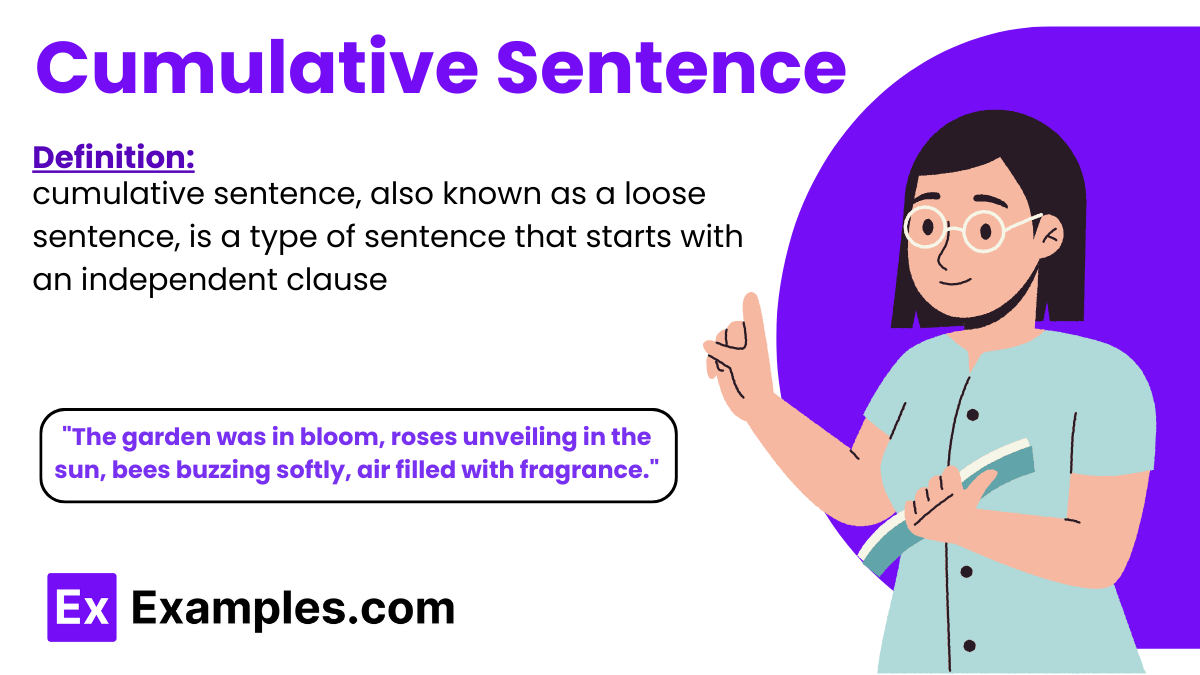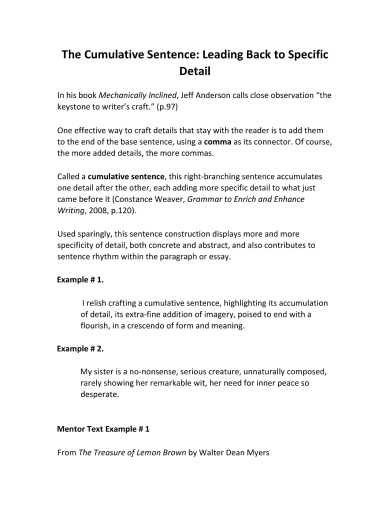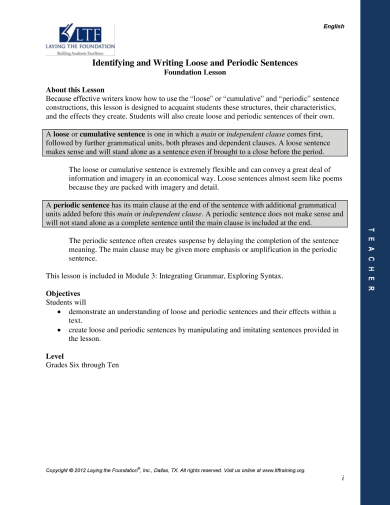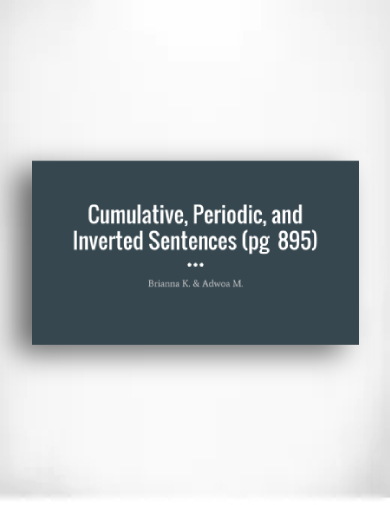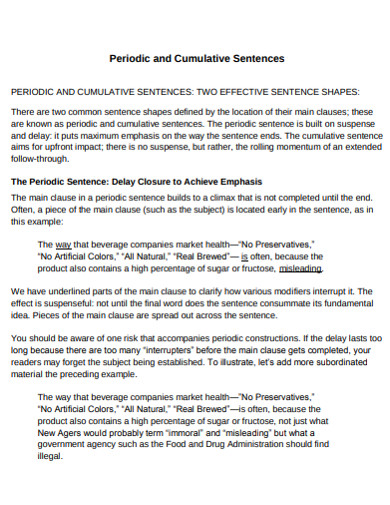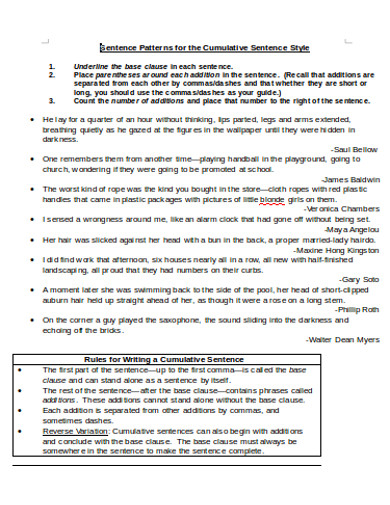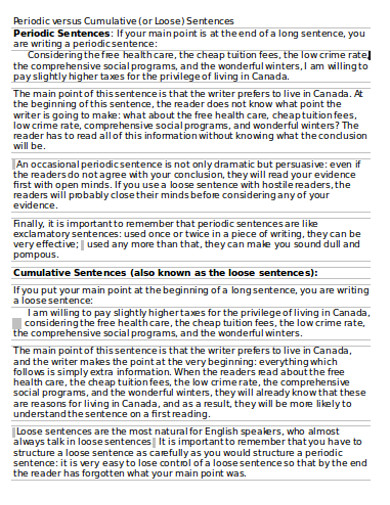10+ Cumulative Sentence Examples
Sentences are one of the basic elements that we use in our every textual need. It may sound very elementary at first, but if you are merely looking at its definition of having subject and predicate that depicts a complete thought, you are barely seeing the surface of simple sentences. In this article, we are going to discuss deeper about sentences. Particularly, we are going to talk about an arrangement of sentences called “cumulative sentences.” Read through to learn more.
What is a Cumulative Sentence?
A cumulative sentence, also known as a loose sentence, is a type of sentence that starts with an independent clause (a complete thought) and then adds subordinate elements or modifiers that provide additional information, detail, and context. The main clause comes first and is followed by phrases and clauses that embellish or explain it. This sentence structure allows the writer to capture a stream of thoughts, adding depth and detail as the sentence unfolds, often creating a sense of movement and accumulation of imagery or argument.
Usage of Cumulative Sentences
One way of effectively using this type of sentence is when you would be explaining theories. In explaining theories, it is often suggested that you introduce the main idea first at the beginning of the sentence. After introducing the main idea, it is then suggested that you add more information in order to prove your main idea. You may also see the Balanced Sentences
Another way to make use of cumulative sentences is to create a scene for panning (like in movies). You could use it when the scene introduces a critical moment or when a character reminisces a memory. You may also see the Periodic Sentences.
How to Write a Cumulative Sentence
Cumulative sentences are beneficial in various scenarios. It can be used in the practical field such as literature and studies, but it is also effective in expressing your thoughts in casual events like talking to your friend, parents, workmates, etc. As much as we use it in speaking, there are some cases that we are obliged to write them down. At this point, we are going to give a comprehensive, step-by-step guideline to educate you in composing a cumulative sentence properly.
1. Know the fundamentals of a cumulative sentence.
Assuming that you are ordered to write the phone number of a stranger unless if you are a psychic, you cannot just directly write digits without asking the person. Similarly, it would be a challenging task for you to compose one without knowing the basics in writing a cumulative sentence. By this, we are referring to the definition, structure, etc., basically, anything about this type of sentence.
2. Create a message.
Crafting a message is not necessarily writing, you can simply imagine the idea of a sentence you want to write. Moreover, it is important to remember that you don’t need to write a whole book or essay, let’s focus more on writing a sentence. So, in constructing a message, keep it as concise as possible and make sure that you understand your own idea, too.
Furthermore, in doing this step, it is recommendable to not stick with formal concepts. Hence, it is better to think of something that is parallel with your interest. Music, arts, sports, nature—the sky is your limit, you decide.
3. Apply the cumulative sentence structure.
By definition, the structure of the cumulative sentence begins with an independent clause and is followed by the subordinate elements or modifiers. To help you understand further, an independent clause is a clause that could stand alone by itself as a simple sentence because it contains a subject and a predicate and depicts a complete thought. Often, a cumulative sentence can also be distinguished as complex ones.
To illustrate, let’s talk about the arts. Here are two clauses that should build a cumulative sentence:
- Louise loves vibrant colors
- like yellow, pink, and sky blue
From these two clauses, let’s identify which is the independent clause. If you got it right, the first one should be your choice. So, simply state it first, followed by the second one as presented below:
Louise loves vibrant colors like yellow, pink and sky blue.
In this sentence, “like yellow, pink and sky blue” acted as the modifier since it described or expounded on the vibrant colors Louise loves. For you to understand more, simply ponder on these numerous sample sentences.
Cumulative Sentence Examples
1. I went to the mall yesterday, bought shirts and bags, and ate at the newly-opened restaurant.
2. The Philippines is a great vacation spot for families and friends, with beaches and other natural tourist spots to enjoy. You may also see the sentence fragment.
3. I could tell my father is mad from his silence and indifference towards us.
4. You can pass the exam with good study habits and good night sleep.
5. She decided to major in nursing, even though she really wanted to study architecture or engineering.
6. He finally completed his assignment after a long day of meetings and a long night of hard work. You may also see the compound sentences.
7. Alisha cut classes without telling anyone from her circle of friends and family.
8. We soon became fond of each other, due to our love for books and the mysterious aura he exudes.
9. Mia made some great do-it-yourself project videos on her YouTube channel, including a video on life hacks.
10. I like all kinds of song genres, like rock, pop, classical, RnB and hip-hop.
11. The spoiled baby started crying when she didn’t get her toys and milk at the usual time.
12. Her husband was elated when he held their baby for the first time after his wife gave birth.
Examples of Cumulative Sentences in Literature
Here are some examples of cumulative sentences in literature. Take note of the texts in bold.
1. More Die of Heartbreak by Saul Bellow
“The radiators put out lots of heat, too much, in fact, and old-fashioned sounds and smells came with it, exhalations of the matter that composes our own mortality, and reminiscent of the intimate gases we all diffuse.” You may also see exclamatory sentences.
2. Some Dreamers of the Golden Dream by Joan Didion
“The San Bernardino Valley lies only an hour east of Los Angeles by the San Bernardino Freeway but is in certain ways an alien place: Not the coastal California of the subtropical twilights and the soft westerlies off the Pacific but a harsher California, haunted by the Mojave just beyond the mountains, devastated by the hot dry Santa Ana wind that comes down through the passes at 100 miles an hour and whines through the eucalyptus windbreaks and works on the nerves.” You may also see the complete and incomplete sentences.
3. Life and Times of Chaucer by John Gardne
“The unwieldy provision carts, draught horses, and heavily armed knights kept the advance down to nine miles a day, the huge horde moving in three parallel columns, cutting broad highways of litter and devastation through an already abandoned countryside, many of the adventurers now traveling on foot, having sold their horses for bread or having slaughtered them for meat.” You may also see the preposition sentences.
4. Gentlemen of the Road by Michael Chabon
“He wept silently, after the custom of shamed and angry men, so that when the pursuit party came tumbling, pounding, scrabbling down the trail, past the fold in which he and Hillel stood concealed, he could hear the creak and rattle of their leather armor with its scales of horn; and when the Arsiyah returned, just before daybreak, at the very hour when all of the creation seemed to fall silent as if fighting off tears, Zelikman could hear the rumbling of the men’s bellies and the grit in their eyelids and the hollowness of failure sounding in their chests.” You may also see the run on sentences.
5. A Modest Proposal by Jonathan Swift
“I have been assured by a very knowing American friend of my acquaintance in London, that a young healthy child well nourished is at a year old a most delicious, nourishing, and wholesome food, whether stewed, roasted, baked or boiled; and I make no doubt it will equally serve in a fricassee or a ragout.” You may also see the interrogative sentences.
6. An American Childhood by Annie Dillard
“I write this at a wide desk in a pine shed as I always do these recent years, in this life I pray will last, while the summer sun closes the sky to Orion and to all the other winter stars over my roof.”
7. Plainsong by Kent Haruf
“Here was this man Tom Guthrie in Holt standing at the back window in the kitchen of his house smoking cigarettes and looking out over the back lot where the sun was just coming up.” You may also see negative sentences.
The texts that are in bold are the main idea and the rest are the details. If you have noticed the supporting details are quite long and that it already seemed like a run-on sentence. All you have to do is to make sure that you use parallelism to keep related ideas in a similar form.
Functions of Cumulative Sentence
Even though cumulative sentences can be lengthy, it cannot be denied that is easier to understand. This is because it is expressed in a straightforward and simple manner that you would already understand the thought of the sentence before you arrive in the middle part. You may also see the Conditional Sentence – Definition and Examples.
Even though the details are written after the main idea are just add-ons, they are relatively important. The additional details expound the main idea further given that the main idea is usually expressed in a straightforward manner. You may also see the Different Types of Transitional Phrases and Sentences.
While there are some people who would find this type of sentence strange, this type of sentence is helpful in helping authors reach their goals. There are writers who are very detailed in the scenes they write, thus relying on cumulative sentences to make it work. However, writers who specialize in horror genres cannot use this type of sentence because an explanation or information is added after the main point of the sentence has been written, removing the element of surprise or shock which is the main goal of horror/suspense stories. You may also see the Parallel Sentences — Structure and Examples.
If you want to narrate events, you can make use of a cumulative sentence because it gives an informal, conversational, and relaxed feeling to the people you are talking to. You may also see How to Write Short Sentences.
You also have to admit that not all people like to read. There are some people who would find intricate details annoying and unnecessary that they would immediately look for the main idea of the sentence. With cumulative sentences, you can actually appeal to those kinds of readers. It helps your readers maintain their interest while also giving them immediately the main idea of the sentence. You may also see the compound sentences.
What Is the Difference between Cumulative and Periodic Sentences?
| Aspect | Cumulative Sentence | Periodic Sentence |
|---|---|---|
| Definition | Begins with the main clause followed by additional details or modifiers. | Begins with subordinate clauses or phrases, building towards the main clause at the end. |
| Structure | Main idea or independent clause comes first, creating an immediate clear point, followed by elaborating details. | Suspense or information builds up through subordinate elements, leading to the main clause for a strong finish. |
| Main Clause Position | At the beginning. | At the end. |
| Purpose | To put the emphasis on the main idea from the start, then add detail. | To create suspense or interest by delaying the main idea until the end. |
| Effect on Reader | Provides clarity and detail progressively, allowing immediate understanding of the core idea. | Keeps the reader in suspense or anticipation, emphasizing the conclusion. |
| Example | “The sun set over the mountains, casting a pink glow, silhouetting the trees, cooling the air.” | “Despite the rain, the cold, and the mud, the festival carried on with undiminished spirit.” |
Cumulative and periodic sentences are both presented as complex sentences in common cases. Otherwise stated, these two sentence types have an independent clause and dependent clauses. These sentences could actually be confusing, especially if you are not well-informed of the key dissimilarities of the independent and dependent clauses. However, if you already mastered distinguishing these basic variations, you’ll realize how easy it is to identify which one is a periodic sentence and which is cumulative.
Now, to explain further, though both sentence type uses the same types of phrases, the way these clauses are applied differs. Unlike the cumulative sentence, the periodic ones start with the subordinate or dependent clauses and state the independent clause at the end of the sentence. Because of this structure, periodic sentences are highly effective in emphasizing points or creating suspense or thrilling sense in depicting an idea.
Tips to write Cumulative Sentence
- Start with a Strong Base: Begin your sentence with a concise independent clause that can stand alone as a complete thought.
- Add Relevant Details: Follow the main clause with subordinate clauses, phrases, or modifiers that elaborate on the initial idea, adding depth and detail.
- Use Descriptive Language: Employ vivid imagery and sensory details in your additions to paint a more vivid picture for the reader.
- Maintain Logical Flow: Ensure that the added details flow logically and cohesively from the main clause, maintaining clarity throughout the sentence.
- Control the Length: While cumulative sentences are typically longer due to their added details, be mindful not to overextend and risk confusing the reader.
- Punctuate Properly: Use commas, dashes, and semicolons appropriately to separate the additional details and maintain readability.
- Balance Your Sentence: While elaborating, ensure that the sentence remains balanced in terms of information and structure to keep the reader engaged.
- Focus on Coherence: Make sure that all the details added are relevant to the main clause and contribute to the overall message or image you are trying to convey.
- Vary Your Starters: Begin your expansions with varying words or phrases (such as adjectives, adverbs, participial phrases) to keep the sentence interesting.
- Practice and Experiment: Practice writing cumulative sentences in different contexts to become comfortable with the structure and discover what works best for your style.
Comprehensible Cumulative Sentence Guide
Simple Cumulative and Periodic Sentences Guide
Effective Loose Sentence Writing Guide
Magnificent Cumulative, Periodic, and Inverted Sentences Guide
Professional Cumulative Sentence Writing Guide
Basic Cumulative Sentence Example
Cumulative Sentence in PDF
Printable Cumulative Sentence
- Build Imagery: Poets use cumulative sentences to pile up images, creating a vivid, multi-faceted picture in the reader’s mind. Each subsequent phrase or clause adds another brushstroke to the poem’s landscape.
- Convey Emotion: By accumulating details and observations, these sentences can gradually intensify the emotional weight of a poem, leading the reader to a more profound empathetic connection.
- Create Rhythm and Musicality: The repetitive structure of cumulative sentences, with their series of additions, can contribute to the poem’s rhythm, enhancing its musicality and flow.
- Enhance Themes: Cumulative sentences can be a method to explore and reinforce the poem’s themes, layering idea upon idea to deepen the reader’s understanding and engagement.
- Invoke a Sense of Overwhelming: Through the accumulation of details or sensations, cumulative sentences can effectively convey feelings of overwhelm, abundance, or intensity, mirroring the poem’s mood or subject matter.
Functions of Cumulative Sentences:
- Creating Depth: By adding successive details, cumulative sentences allow for a deeper exploration of a topic, character, or scene.
- Enhancing Imagery: The added details can paint a vivid picture, making descriptions more immersive and engaging.
- Improving Clarity: They can clarify the main clause by providing additional context, explanations, or specifics.
- Adding Emphasis: The accumulation of details can emphasize the importance or impact of the main idea.
- Building Rhythm: The rhythmic buildup of details contributes to the overall flow and musicality of the prose or poetry.
- Facilitating Persuasion: In persuasive writing, cumulative sentences can pile up evidence or arguments, making a stronger case.
- Creating Suspense or Interest: Although the main idea is presented first, the unfolding details can create a sense of anticipation or deepen interest in the subject.
How Cumulative Sentences Enhance Characterization:
- Adding Depth: Cumulative sentences allow writers to add depth to their characters by appending descriptive details and traits seamlessly, enriching the reader’s understanding of the character’s nature, motivations, and complexities.
- Revealing Through Action: Starting with an action in the main clause and elaborating with details can reveal character traits implicitly. For example, “John donated his prize money, a generous act, surprising to his friends, characteristic of his quiet benevolence,” shows John’s generosity and modesty without stating them outright.
- Building Visual Imagery: By detailing physical appearance, expressions, and gestures, cumulative sentences can create a vivid visual image of characters, making them more memorable and relatable to readers.
- Conveying Emotional Complexity: The accumulation of details can effectively convey the layers of a character’s emotional state or the complexity of their thoughts, providing insight into their psychological makeup.
- Setting the Tone: The rhythm and flow of cumulative sentences can mirror a character’s mood or the atmosphere surrounding them, subtly setting the tone of the scene or narrative.
- Illustrating Relationships: The details added in cumulative sentences can also reveal dynamics and relationships between characters, highlighting affinities, conflicts, or tensions through descriptions of interactions or reactions.
Putting Together a Cumulative Sentence
- Start with a Main Clause: Begin with a clear and concise independent clause that introduces a basic idea or action. This is the foundation of your sentence.
- Example: “The garden was in full bloom.”
- Add Descriptive Details: Next, append descriptive details to the main clause to enhance the imagery or expand on the idea. These can describe the senses, emotions, or additional context.
- Adding detail: “, its colors a dazzling array of yellows and purples,”
- Incorporate Action or Movement: Include phrases that add action or a sense of movement related to the main clause to bring dynamism to the sentence.
- Adding action: “, bees buzzing softly among the petals,”
- Introduce Characters or Elements: You can add characters or other elements that interact with or relate to the main clause, offering further depth or perspective.
- Introducing a character: “, watched over by an old, smiling gardener,”
- Layer in Atmosphere or Emotion: Further embellish the sentence with phrases that convey the atmosphere, emotional context, or implications of the initial idea.
- Adding atmosphere: “, under a sky so blue it seemed to promise endless summer.”
- Conclude with a Reflective or Summative Phrase: Optionally, end with a phrase that reflects on the cumulation of details or offers a summative insight, tying everything back to the main clause.
- Concluding insight: “, a peaceful haven from the world’s hustle.”
FAQs
What is Cumulative in Writing?
Cumulative in writing refers to the accumulation of details or modifiers after an initial statement or main clause, enriching the sentence with additional information, imagery, or context to enhance its depth and clarity.
What You Mean by Cumulative?
Cumulative refers to an increase or accumulation over time, often relating to the addition of successive layers or elements that build upon each other, enhancing the overall effect or result.
How Do You Use Cumulative Impact in a Sentence?
“The cumulative impact of sleepless nights and relentless stress began to wear on her health, visibly draining her energy and focus.”
What is Cumulative in School?
In a school context, cumulative refers to the aggregation of student performance over a period, such as cumulative grades or scores, indicating the overall achievement or progress rather than isolated instances.
What are the 5 Most Common Sentencing?
The five most common types of sentencing include: probation, fines, short-term incarceration, long-term prison sentences, and capital punishment, each depending on the severity and nature of the crime.


